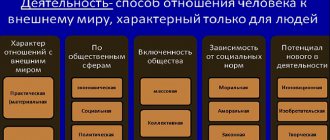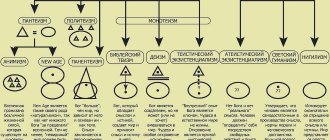Temperament is a set of mental and physiological traits of a person that determine the nature of his reactions to external stimuli. The latter includes everything around us: other people, animals, events, circumstances, etc.
In the Unified State Examination in social studies, temperament is a headache for all test takers. True, they do not realize this, but understand only after passing the exam. To avoid having your scores lowered on this topic, you need to clearly understand what temperament is? In this article, briefly and in simple words, we’ll talk about just that!
By the way, before reading this article, I recommend the articles: what is personality and about the concept of individuality, human personality.
What is temperament
Temperament is a complex of individual personality characteristics that determine the dynamics of its behavior and mental activity.
Temperament
It is laid down at birth and depends on the nervous structure of the body, the type of its higher nervous activity.
Each type is a variant of the norm and has its own positive and negative features. Character is formed on its basis. Temperament cannot be changed. You can only correct its manifestations. Character changes in the process of development, with the help of education, under the influence of society.
Is it necessary to take into account the type of temperament when selecting people for joint activities?
It is interesting that in conditions of joint activity of people (for example, two), the dynamic traits of their temperament have a more significant impact on the final result of their activity than in cases where everyone works individually. At the same time, more favorable and less favorable combinations of different types of temperament for performing a given activity are discovered. So, for example, the activity of a choleric person turns out to be more effective in cases where he works together with a phlegmatic or melancholic person than when his partner is a sanguine person or, especially, a choleric person (research by V.M. Rusalov).
Properties of temperament
The properties of temperament determine the mental activity of a person in dynamics. The severity of traits depends on gender. A man more often shows a desire for action. His activity, efficiency, reactivity, plasticity and rate of reactions are higher than those of a woman.
Sensitivity
Sensitivity (sensitivity) is a characteristic that reflects the threshold of minimal impact that can cause a mental reaction.
The lower the intensity of the stimulus, the higher the sensitivity.
Reactivity
A property such as reactivity characterizes the speed of development and intensity of the mental response to an external or internal stimulus (criticism, screaming, pain).
These are involuntary defensive reactions. For example, short temper is the result of high reactivity. So, it is greatest in the choleric type of temperament.
Activity-passivity
The activity of temperament determines the energy potential of a person, which he uses to influence the world around him and himself, for example, to overcome obstacles, achieve a goal, etc. This is the readiness for self-expression and self-realization. To determine the degree of activity, characteristics such as persistence, determination, and concentration are used.
Temperamental energy manifests itself in all areas of a person’s life: in the family, in the profession, on vacation. The greatest activity is characteristic of phlegmatic people, the least - of melancholic people.
Passivity is activity that has a negative polarity. In this case, one can observe lethargy of behavior, inertia, lack of initiative, and a tendency to contemplate.
Plasticity-rigidity
These properties characterize a person’s ability to adapt to the influence of an external stimulus or to new conditions, as well as the speed with which his adaptation occurs.
Plasticity determines the flexibility of the psyche, a short adaptive period in case of changing circumstances and a quick change in behavior patterns in accordance with new requirements.
If a person is more rigid, he will show inertia and will slowly adapt to changing conditions, relying on the old model of behavior.
Plasticity is manifested in sanguine people, rigidity - in choleric, phlegmatic and melancholic personality types.
Extraversion-introversion
The terms “extraversion” and “introversion” were introduced to define the dependence of human reactions and activity on external (people, circumstances, things) or internal (thoughts, feelings, emotions) irritating factors.
Introversion is a temperamental property characterized by a focus on internal mental activity. He is characterized by isolation and a desire for privacy.
Extraversion manifests itself as a concentration on the external world. An extrovert is characterized by such traits as sociability, friendliness, talkativeness, and energy. One personality often exhibits both extroversion and introversion, but in different proportions.
Excitability of emotions
This is a property of temperament that reflects the minimum borderline level of influence that is necessary for the occurrence of emotional reactions and the speed of their development.
The indicator is especially high in melancholic and choleric personality types, low in phlegmatic people.
Rate of reactions
The pace of reactions reflects the speed of mental processes and states. To do this, various indicators are analyzed: intelligence, speed of speech, dynamics of gestures.
A low pace leads to a person reacting slowly to stimuli. For example, he does not have time to follow the interlocutor’s train of thought. The highest rate of reactions is characteristic of the choleric type.
Differences between temperament and character
Temperament is the foundation for a larger characteristic of the human personality - character. Sometimes these concepts are not distinguished and confused, although, in a strict sense, they are not the same thing. It was said above about acquired skills, habits, character traits and their difference from innate ones. So, character is precisely the acquired mental properties, although formed under the influence of innate qualities.
The character of representatives of different temperaments may be the same, but it manifests itself in different ways. Thus, phlegmatic people and sanguine people can be equally sociable, but the external manifestation of this sociability will be significantly different. Some specific innate qualities can predetermine the development of some character traits and counteract the emergence of others. It also happens that the development of certain character traits allows a person to restrain negative and currently undesirable innate properties; this phenomenon lies, in particular, at the basis of willpower.
Knowledge about the dependence of innate and acquired qualities allows you to find an individual approach to raising children. A child with any personality type (melancholic, choleric, sanguine or phlegmatic) can develop any character traits, but the methods of education must be different.
Let's return to outstanding personalities. Mikhail Illarionovich Kutuzov was a phlegmatic person by nature, but the corresponding innate mental properties alone could not have made him a famous commander - a choleric person would have been more useful here. Education, training and self-improvement made Kutuzov the way he went down in history.
Isaac Newton seems to us a pronounced phlegmatic person, but his contemporaries described him as a typical melancholic person. Russian Emperor Nicholas I was also melancholic, famous for his harsh “stick” regime of government, military discipline and ruthless fight against corruption - that is, all that, in theory, should reveal a choleric person in him.
In general, character is something that needs training, development and hardening. As a result, even a person with weak innate abilities can show strength of character. This is often observed in emergency situations - for example, during war.
Methods for classifying psychotypes
There are several concepts for classifying psychotypes. Some of them are already outdated.
According to the processes of excitation-inhibition
Personality typology I.P. Pavlova is based on the fact that human behavior directly depends on the basic nervous processes - excitation and inhibition. The main parameters of these processes in various combinations form four types of higher nervous activity:
- sanguine - strong, balanced, agile type;
- phlegmatic - strong, balanced, inert type;
- choleric - strong, unbalanced, mobile;
- the only weak type is the melancholic.
Strength is the ability of the nervous system to resist the effects of strong stimuli. A strong nervous system is characterized by good performance, restraint, patience and perseverance. Weak ones are characterized by rapid fatigue, low endurance, and anxiety.
Balance depends on the correlation of excitation and inhibition with each other. A person with a balanced nervous system has discipline and the absence of sharp emotional fluctuations. An unbalanced person is incapable of waiting and suffers from sleep disorders.
Mobility determines the rate of alternation of inhibition and excitation. An active temperament is characterized by rapid adaptation, mental agility, active motor skills and speech articulation.
Galen's typology
The ancient physician Gallen suggested that the stable individual characteristics of a person and his behavior are in correlation with chemical processes in the body and depend on the predominance of one of the vital fluids in it. He identified the following types of temperaments:
- A phlegmatic person is a person whose body is dominated by viscous lymph (phlegm) - calm and slow.
- Choleric is a person who produces a lot of bitter bile (“chole” in other Greek) - hysterical, hot-tempered, rude.
- A sanguine person is an individual whose body is dominated by blood (“sangvis” in Latin) - active, cheerful.
- A melancholic person is one who has the most black bile in the body (“melena chole” in Greek) - anxious, sad, withdrawn.
According to the ratio of signaling systems
The first signaling system is conditioned reflexes that arise under certain environmental conditions. These are impressions and sensations from external conditions - natural and social, which allow you to form your own idea of the current situation and surrounding objects.
The second signaling system is higher, abstract thinking, closely connected with speech, which allows one to escape from reality and allows generalization
The typology in this case is based on the ratio of 1 and 2 signaling systems, as a result of which the following psychotypes are distinguished:
- Art. It is characterized by the predominance of conditioned reflexes over abstract thinking. A person with an artistic temperament perceives the surrounding reality figuratively, relying on feelings.
- Thoughtful. This psychotype is characterized by a predominance of abstract thinking over reflexes. People with this temperament are able to build logical chains and think abstractly.
- Harmonious. This is an intermediate psychotype, which is characterized by balance, an equal ratio of 1 and 2 signal systems. The majority of people belong to this type.
Kretschmer's constitutional theory
E. Kretschmer's constitutional typology of temperaments is based on the relationship between the structure of the body and the mental characteristics of a person. Depending on the prevailing emotional reactions, Kretschmer identified 2 groups of people
- Diadetic, which is characterized by changes in mood on the “cheerful-sad” scale. People from this group have a cyclothymic type of temperament with signs of the behavior of patients with manic-depressive syndrome: mood swings from joy to sadness, sociability, and a realistic view of the world.
- Psychoaesthetic, which is characterized by a change in sensitivity on the “sensitive-insensitive” scale. They are characterized by a schizothymic (close to schizophrenia) type of temperament. These are closed people, prone to emotional fluctuations from irritation to indifference, to abstraction, stubborn people who do not adapt well to new conditions and surroundings.
What is an individual style of activity?
One of the important scientific problems in the study of temperament is the problem of taking into account and mastering the psychodynamic characteristics of human behavior in various types of activities. The existence in the human psyche of stable dynamic energy characteristics, formed on the basis of biological factors, allows a person to use his energy capabilities in the most optimal way. Knowing his energy characteristics, a person can consciously regulate the regime, rhythm, and intensity of various types of activity. In psychological studies Merlina V.S., Klimova E.A. the problem of taking into account and mastering an individual’s psychodynamic characteristics is associated with the development of an individual style of activity. Individual characteristics of a person determine an individual style of activity (E.A. Klimov), which is:
- a sustainable system of techniques and methods of activity;
- this system is conditioned by certain individual personal qualities;
- this system is a means of effectively adapting to objective requirements;
- These are those features of the style of activity that are determined by the typological properties of the human nervous system.
An individual style of activity is a stable, individually specific system of psychological means, techniques, skills, methods, and ways of performing a particular activity. The possibility of different individual styles of activity lies in the existence of a “zone of operational uncertainty”, allowing the choice of different ways of carrying out activities. The intensity of motivation for any activity determines the presence and degree of expression of an individual style of activity. It allows people with different individual typological characteristics of the nervous system, different structures of abilities, temperament, and character to achieve equal effectiveness when performing the same activity in different ways, while compensating for individual characteristics that impede the achievement of success. At the same time, the individual style of activity may not be optimal from the point of view of activity efficiency.
Characteristics and features of the main psychological types
There are 4 types of higher nervous activity, on the basis of which temperament is formed: weak (melancholic), unrestrained (choleric), lively (sanguine) and calm (phlegmatic).
Sanguine
A sanguine person is characterized by extraversion, an optimal rate of reaction, reduced sensitivity (does not show sensitivity to trifles, is an optimist), good plasticity, high activity, balanced by reactivity. With high performance, he has low fatigue, a lively but not excessive reaction to stimuli, and emotional stability.
Choleric
This type of temperament is characterized by extraversion, strong emotional excitability, rigidity, high rate of reactions, low sensitivity, pronounced reactivity and activity. Moreover, reactivity predominates. Therefore, he is characterized by short temper, lack of patience, imbalance, and emotional instability.
Rigidity prevails over plasticity. Cholerics quickly become exhausted.
Phlegmatic person
Phlegmatic people are characterized by introversion, low sensitivity and emotional excitability. They are calm and have limited facial expressions.
They have a slow pace of reactions, high activity with low reactivity, which allows them to perfectly control their emotions, thoughts and actions. They are characterized by good self-control, restraint, patience, and emotional equanimity.
Melancholic
Melancholic people are characterized by introversion, pronounced sensitivity, high emotional excitability against a background of rigidity, inertia, passivity and low reactivity, depression.
Temperament with such properties is manifested by tearfulness, timidity, touchiness, vulnerability, indecision, cowardice, isolation, self-doubt, inhibited reaction to strong stimuli, low performance and fatigue, unstable attention.
How to use knowledge about temperament to your advantage
Information about temperament brings practical benefits in many areas of life. Knowing your own temperament, you can more accurately determine your capabilities, strengths and weaknesses, and the vector of applying effort to master new skills or compensate for shortcomings. Knowing the child’s temperament, you can choose the most effective methods of education, adjust the requirements and help in choosing a profession. Knowing the temperament of other people helps to understand them better, be more flexible in contact, more clearly define the strategy of one’s behavior, and adapt to someone else’s style of communication.
Experts in the field of psychology say that representatives of all four types of temperaments can be given general recommendations to compensate for shortcomings:
- A choleric person should take into account that his activity sometimes becomes destructive.
- Sanguine - that when solving important issues it is worth being more serious.
- Phlegmatic - that it is necessary to show more speed and flexibility.
- To a melancholic person - that ordinary failures, troubles and mistakes are not a life disaster.
There are recommendations for organizational work and communication with people, taking into account their temperament:
- Choleric - “get busy.”
The activity of a choleric person can bring rich fruits if directed in a constructive direction. A choleric person who is idle and bored may begin to become distracted or do something destructive. The best option is to let a person choose an activity for himself; this is usually not difficult for an idea generator to do. - Sanguine - “trust, but verify.”
Sanguine people value the good attitude of other people; trust is important to them. They can be given complex tasks that require significant effort, and expect good results. At the same time, they should be unobtrusively controlled, because sanguine people can promise something so as not to offend, and then not fulfill the promise because it became uninteresting or they didn’t want to from the very beginning. - Phlegmatic – “don’t rush.”
It is useless to force a phlegmatic person to do so; he is most productive when he works at his own pace. Phlegmatic people usually calculate well the time and effort required to solve a problem, so if a person has taken on something, there is no need to knock him down. How to expect to quickly switch between different tasks. - Melancholic – “do no harm.”
Melancholic people react sharply to negative emotional signals from others; it is better to communicate with them tactfully and with restraint, not forgetting to praise for successes and not bringing shortcomings to public discussion.
Temperament determines methods of action, but not their effectiveness. Representatives of different temperaments can achieve success in the same area, but do it in different ways. Understanding temperament helps a person find his path and go through it with less effort, but with better results.
Definition of temperament and brief instructions for interaction
Groups that include people with different types of temperament work most effectively.
With a choleric person
The choleric type is characterized by impulsiveness, impetuosity and speed of movements, high excitability, harshness in communication, irritability, a tendency to emotional outbursts, and mood swings.
Possible rudeness, hot temper, affectation, inability to control oneself, touchiness. High efficiency is combined with a rapid loss of interest and the inability to complete a task if the process is delayed. Choleric people can be aggressive and often have difficulty communicating. At the same time, choleric people are optimists, they are full of energy, proactive, charismatic, and quickly forgive insults.
Colleagues should not react to the emotional outbursts of a choleric person or enter into an argument with him. A friendly, confident tone, interest in the conversation, and light, harmless humor will help him calm down.
With a sanguine person
Sanguine people are open, lively, friendly, cheerful, inquisitive, sociable people who easily experience failures. They have a flexible mind. They are resourceful, easily absorb information if desired, strive for new experiences and do not tolerate monotonous work well, and easily cope with organizational tasks.
Possible frivolity in work and study, reluctance to bring things to their logical conclusion, overestimation of one’s own capabilities, superficiality of judgment.
Sanguine people make good leaders at any level, capable of inspiring and organizing employees. To establish relationships, polite interest, praise, and recognition of his merits are enough.
With a melancholic person
Melancholic people are soft, tactful, sensitive and responsive, creative people, prone to reasoning. Under normal circumstances, they can be sociable, work well, be persistent and goal-oriented.
These are conscientious and responsible workers. They can be depressed, anxious, gloomy, secretive, and pessimistic. They do not tolerate stress well and do not like to make decisions.
Melancholic people are rarely interested in others. They easily obey, do not participate in competitions, and prefer to remain on the sidelines. You need to talk to a melancholic person calmly, without harsh words or intonations, and often praise.
How to determine a person's temperament
The most reliable way to determine your own temperament type is to take one or more tests (to control and compare results). The test of Eysenck, a famous specialist in the field of psychology, creator of the factor theory of personality, based on the types of people’s temperaments, is very popular. The test consists of 40 questions and is used by both amateurs and professional psychologists. There are tests designed specifically for parents - with their help you can determine the temperament of a child 3-4 years old and older.
The situation becomes more complicated if you need to clarify the temperament of other people who, for some reason, cannot be asked to take the test. In such cases, psychologists recommend focusing on external manifestations characteristic of 4 temperaments:
- Sanguine
. Sociable, talkative, easily becomes part of new companies, finds a common language with previously unfamiliar people. Has expressive facial expressions, actively gesticulates, but facial expressions and gestures do not look sharp or impetuous. Walks quickly but smoothly. Usually has good posture. - Choleric
. It can be incendiary, captivating, or, on the contrary, irritable and rude. Gives the impression of imbalance due to short temper and frequent mood swings. He is sociable, talkative, and due to his expressed emotionality, sometimes “pulls the blanket” over himself, not allowing his interlocutor to speak. He speaks quickly and sharply, has expressive, bright facial expressions, and violent gestures. Movements are sharp and jerky. - Phlegmatic
. Slow, calm, unhurried. He speaks little and to the point, does not like empty chatter. Shows little emotion, gesticulates little. Despite the external inexpressiveness of speech and gestures, he has rich facial expressions. Moves smoothly, unhurriedly. Regardless of build and type of activity, he usually gives the impression of a solid person who stands firmly on the ground. - Melancholic
. Among strangers and in noisy companies, he tends to be passive, silent and inconspicuous. Often avoids new people. In a comfortable environment or alone with a person he likes, he relaxes and opens up. Strong emotions are combined with weak gestures. Can move quickly or slowly, but movements are always restrained. Very observant.
Abstracts For You
INTRODUCTION CHAPTER 1. General concept of temperament CHAPTER 2. Basic properties of temperament CHAPTER 3. Classifications of temperament CHAPTER 4. Psychological characteristics of temperament types CONCLUSION REFERENCES USED
INTRODUCTION
People begin to become familiar with the concept of “temperament” very early. Even in childhood, we notice that some of us are more active, cheerful, persistent, while others are slow, shy, unhurried in words and actions. It is in these features that temperament manifests itself.
The famous psychologist Merlin wrote: “Imagine two rivers - one calm, flat, the other fast, mountainous. The flow of the first is barely noticeable, it smoothly carries its waters, it does not have bright splashes, stormy waterfalls or splashes. The course of the second is the complete opposite. The river rushes quickly, the water in it rumbles, boils and, hitting the stones, turns into shreds of foam... Something similar can be observed in people’s behavior.”
Observations have shown that all people are different not only in appearance, but also in behavior and movements. For example, if you monitor the behavior of students in class, you can immediately notice the difference in the behavior and movements of each one. Some have unhurried, correct movements, a noticeable calmness in their gaze, while others have sudden movements, fussiness in their eyes, but most of them show similar results in development. What explains this difference in behavior? First of all, temperament, which manifests itself in any type of activity (play, work, study, creative), in gait, gestures, in all behavior. The individual characteristics of a person’s personality and his temperament give a unique color to all activities and behavior.
CHAPTER 1. GENERAL CONCEPT OF TEMPERAMENT
When they talk about temperament, they mean many mental differences between people - differences in depth, intensity, stability of emotions, emotional sensitivity, pace, energy of actions and other dynamic, individually stable features of mental life, behavior and activity. Nevertheless, temperament today remains a largely controversial and unresolved problem. However, with all the diversity of approaches to the problem, scientists and practitioners recognize that temperament is the biological foundation on which the personality is formed as a social being.
Temperament reflects the dynamic aspects of behavior, mainly of an innate nature, therefore the properties of temperament are the most stable and constant compared to other mental characteristics of a person. The most specific feature of temperament is that the various properties of a given person’s temperament are not randomly combined with each other, but are naturally connected with each other, forming a certain organization and structure.
So, temperament should be understood as individually unique properties of the psyche that determine the dynamics of a person’s mental activity, which, equally manifested in a variety of activities regardless of its content, goals, motives, remain constant in adulthood and in interconnection characterize the type of temperament.
The properties of temperament include individual characteristics that:
- Regulate the dynamics of mental activity in general;
- Characterize the features of the dynamics of individual mental processes;
- They are stable and permanent in nature and remain in development over a long period of time;
- They are in a strictly natural relationship, characterizing the type of temperament;
- Definitely due to the general type of nervous system.
CHAPTER 2. BASIC PROPERTIES OF TEMPERAMENT
The properties of temperament include those distinctive, individual characteristics of a person that determine the dynamic aspects of all his types of activity, characterize the peculiarities of the course of mental processes, have a more or less stable nature, persist for a long time, appearing soon after birth (after the central nervous system takes on specifically human forms). It is believed that the properties of temperament are determined mainly by the properties of the human nervous system.
Soviet psychophysiologist V.M. Rusalov, relying on a new concept of the properties of the nervous system, proposed on its basis a more modern interpretation of the properties of temperament. Based on the theory of the functional system P.K. Anokhin, which includes four blocks of storage, circulation and processing of information (the block of afferent synthesis, programming (decision making), execution and feedback), Rusalov identified four associated temperament properties that are responsible for the breadth or narrowness of afferent synthesis (the degree of intensity of the body’s interaction with environment), ease of switching from one behavior program to another, speed of execution of the current behavior program and sensitivity to the discrepancy between the real result of an action and its acceptor.
In accordance with this, the traditional psychophysiological assessment of temperament changes and instead of two parameters - activity and sensitivity - it now includes four components: ergicity (endurance), plasticity, speed and emotionality (sensitivity). All these components of temperament, according to V.M. Rusalova, are biologically and genetically determined. Temperament depends on the properties of the nervous system, and they, in turn, are understood as the main characteristics of functional systems that provide integrative, analytical and synthetic activity of the brain and the entire nervous system as a whole.
The psychological characteristics of temperament types are determined by the following basic properties:
Sensitivity - we judge this property by what is the least force of external influences necessary for the occurrence of any psychological reaction in a person, and what is the speed of occurrence of this reaction.
Reactivity - this property is judged by the degree of involuntary reactions to external or internal influences of the same strength.
Activity - this property is judged by the degree of activity with which a person influences the outside world and overcomes obstacles in achieving goals. This includes focus and perseverance in achieving goals, concentration in long-term work.
The ratio of activity and reactivity - this property is judged by the speed of various psychological reactions and processes: speed of movements, rate of speech, resourcefulness, speed of memorization, speed of mind.
Plasticity and rigidity - this property is judged by how easily and flexibly a person adapts to external influences or, conversely, how inert and rigid his behavior, habits, and judgments are.
Extraversion and introversion - this property is judged by what primarily determines a person’s reactions and activities - from external impressions arising at the moment (extroversion) or from images, ideas and thoughts associated with the past and future (introversion).
Emotional excitability - this property is judged by how weak an impact is necessary for the occurrence of an emotional reaction and at what speed it occurs.
CHAPTER 3. CLASSIFICATIONS OF TEMPERAMENT
Different classifications of temperaments rely on their different properties:
1) speed and strength of emotional reactions;
2) level of activity and predominant feeling tone;
3) scales of extraversion (introversion) and neuroticism (emotional stability);
4) reactivity and activity;
5) general mental activity, historian and emotionality.
The similarity noticeable in these classifications shows that the identified psychological characteristics really form a special, fairly clearly defined group of individual properties.
In these examples of classifications, only the most general properties are noted. A more complete list of such properties, including more specific ones, is as follows: sensitivity, reactivity and activity, rate of reactions, plasticity and rigidity, extroversion and introversion, emotional excitability.
According to the teachings of the ancient Greek physician Hippocrates (VI century BC), there are four types of temperament. The body was believed to have four main fluids, or "juices": blood, phlegm, yellow bile, and black bile. Mixed in certain proportions, they make up his temperament. The specific name of the types of temperament was given by the fluid predominant in the body: melancholic, sanguine, phlegmatic and choleric temperament (hence melancholic; sanguine; phlegmatic; choleric).
Psychological teaching about temperament. The approach to temperament characteristic of this teaching is to proceed from the analysis of only behavior. When determining temperament, as a rule, the sign of innate or organic foundations does not appear, and the main load is on the sign of “formal-dynamic properties of behavior,” which are abstracted from holistic behavioral acts. But here a significant difficulty is revealed: this feature also does not allow us to unambiguously resolve the issue of the range of specific properties that should be attributed to temperament. And the tendency to expand the range of such properties leads to a confusion of temperament with character and even personality.
Physiological doctrine of temperament. Throughout the long and complex history of the study of temperament, it has always been associated with the physiological characteristics of the body. One of the most serious attempts to provide a physiological basis for temperament is associated with the names of I. P. Pavlov, B. M. Teplov and Nebylitsyn. Initially, this concept was called the doctrine of the types of the nervous system, later - the doctrine of the properties of the nervous system.
Regardless of the listed hypotheses about the physical foundations of temperament, there is a growing conviction that its properties are most clearly manifested in those forms of behavior that are directly related to the energy expenditure of the body - with the methods of accumulation and expenditure of energy and the quantitative characteristics of processes. Therefore, most temperament researchers paid attention, first of all, to the emotional and motor reactions of the individual, especially emphasizing their formal aspect, that is, their strength (intensity) and course over time.
A classic example of this approach is the typology of temperaments by W. Wundt, the creator of experimental psychology. He understood temperament as a predisposition to affect, which was expressed in the following thesis: temperament is for emotion what excitability is for sensations. Based on this understanding, W. Wundt identified two bipolar properties of temperament, namely the strength and speed of change of emotion, emphasizing the importance of the individual’s energy characteristics.
Classification of temperaments (according to Wundt)
| Speed of change of feelings | Strength of feelings | |
| strong | weak | |
| fast | choleric | sanguine |
| slow | melancholic | phlegmatic person |
We find in W. Wundt an extremely important idea that each temperament has its positive and negative sides, and this, in particular, means that proper education involves using the advantages of a given temperament and at the same time leveling out the negative influence that it may have influence an individual's behavior.
There remains confidence that the dynamic properties of behavior manifested in temperament have a physiological basis - certain features of the functioning of physiological structures. The question of what these structures and features are is being intensively researched. There are different opinions about what specific characteristics of the body should be associated with temperament - hereditary or simply physiological, which can be formed during life. There is a fundamental difficulty here: it has not yet been established what, in terms of behavior, is a manifestation of the genotype (refers to temperament), and what is the result of lifetime layers (refers to character).
CHAPTER 4. PSYCHOLOGICAL CHARACTERISTICS OF TYPES OF TEMPERAMENT
The ancient Greek physician Hippocrates, who lived in the 5th century BC, described four temperaments, which were given the following names: sanguine temperament, phlegmatic temperament, choleric temperament, melancholic temperament. He described the main types of temperaments, gave them characteristics, but connected temperament not with the properties of the nervous system, but with the ratio of various fluids in the body: blood, lymph and bile. The first classification of temperaments was proposed by Galen, and it has survived to this day in a relatively little changed form. The last known description of it, which is also used in modern psychology, belongs to the German philosopher I. Kant.
I. Kant divided human temperaments (manifestations of temperament can also be seen in higher animals) into two types: temperaments of feeling and temperaments of activity.
According to I.P. Pavlov, temperaments are the “main features” of a person’s individual characteristics.
Below is a psychological description of the four types of temperaments:
Sanguine temperament.
A sanguine person quickly gets along with people, is cheerful, easily switches from one type of activity to another, but does not like monotonous work. He easily controls his emotions, quickly gets used to a new environment, and actively comes into contact with people. His speech is loud, fast, distinct and is accompanied by expressive facial expressions and gestures. But this temperament is characterized by some duality. If stimuli change quickly, novelty and interest of impressions are maintained all the time, a state of active excitement is created in a sanguine person, and he manifests himself as an active, active, energetic person. If the influences are long-lasting and monotonous, then they do not maintain a state of activity, excitement, and the sanguine person loses interest in the matter, he develops indifference, boredom, and lethargy.
A sanguine person quickly develops feelings of joy, grief, affection and hostility, but all these manifestations of his feelings are unstable, do not differ in duration and depth. They arise quickly and can disappear just as quickly or even be replaced by the opposite. The mood of a sanguine person changes quickly, but, as a rule, a good mood prevails.
Phlegmatic temperament.
A person of this temperament is slow, calm, unhurried, and balanced. In his activities he demonstrates thoroughness, thoughtfulness, and perseverance. As a rule, he finishes what he starts. All mental processes in a phlegmatic person seem to proceed slowly. The feelings of a phlegmatic person are poorly expressed outwardly; they are usually inexpressive. The reason for this is the balance and weak mobility of nervous processes. In relationships with people, a phlegmatic person is always even-tempered, calm, moderately sociable, and has a stable mood. The calmness of a person of phlegmatic temperament is also manifested in his attitude towards events and phenomena in life, a phlegmatic person is not easily enraged and emotionally hurt. It is easy for a person of phlegmatic temperament to develop self-control, composure, and calmness. But a phlegmatic person should develop the qualities he lacks - greater mobility, activity, and not allow him to show indifference to activity, lethargy, inertia, which can very easily form under certain conditions. Sometimes a person of this temperament may develop an indifferent attitude towards work, towards life around him, towards people and even towards himself.
Choleric temperament.
People of this temperament are fast, excessively mobile, unbalanced, excitable, all mental processes occur quickly and intensely in them. The predominance of excitation over inhibition, characteristic of this type of nervous activity, is clearly manifested in the incontinence, impetuosity, hot temper, and irritability of the choleric person. Hence the expressive facial expressions, hasty speech, sharp gestures, unrestrained movements. The feelings of a person with choleric temperament are strong, usually clearly manifested, and arise quickly; the mood sometimes changes dramatically. The imbalance characteristic of a choleric person is clearly associated with his activities: he gets down to business with increasing intensity and even passion, showing impetuosity and speed of movements, working with enthusiasm, overcoming difficulties. But in a person with a choleric temperament, the supply of nervous energy can quickly be depleted in the process of work, and then a sharp decline in activity may occur: elation and inspiration disappear, and the mood drops sharply. In communicating with people, a choleric person admits harshness, irritability, and emotional incontinence, which often does not give him the opportunity to objectively evaluate people’s actions, and on this basis he creates conflict situations in the team. Excessive straightforwardness, hot temper, harshness, and intolerance sometimes make it difficult and unpleasant to be in a group of such people.
Melancholic temperament.
Melancholic people have slow mental processes, they have difficulty reacting to strong stimuli; Prolonged and strong stress causes people of this temperament to slow down their activity and then stop it. Melancholic people are usually passive in their work, often with little interest (after all, interest is always associated with strong nervous tension). Feelings and emotional states in people of melancholic temperament arise slowly, but are distinguished by depth, great strength and duration; melancholic people are easily vulnerable, have a hard time withstanding insults and grief, although outwardly all these experiences are poorly expressed in them. Representatives of a melancholic temperament are prone to isolation and loneliness, avoid communicating with unfamiliar, new people, are often embarrassed, and show great awkwardness in a new environment. Everything new and unusual causes melancholics to become inhibited. But in a familiar and calm environment, people with this temperament feel calm and work very productively. It is easy for melancholic people to develop and improve their characteristic depth and stability of feelings, increased susceptibility to external influences.
“Pure” temperaments are relatively rare. There are transitional, mixed, intermediate types of temperament; Often a person's temperament combines traits of different temperaments.
CONCLUSION
Features of the type of higher nervous activity and the properties of temperament have long attracted the attention of researchers. However, the data they obtained is extremely contradictory. Many theories and study methods have been put forward.
Beginning in the mid-18th century, theories of temperament related to certain properties of the nervous system developed. Thus, Albrecht Haller, the founder of experimental physiology, who introduced the concepts of excitability and sensitivity, which are important for psychology, argued that the main factors for differences in temperament are the strength and excitability of the blood vessels themselves through which blood passes. This idea was adopted by A. Haller’s student, G. Wrisberg, who connected temperament directly with the characteristics of the nervous system. Thus, he believed that the choleric sanguine temperament was based on a large brain, “strong and thick nerves” and high excitability of the senses. The idea of connecting the characteristics of temperament with certain anatomical and physiological characteristics of the nervous system in various forms is manifested in the teachings of many philosophers and doctors of the 18th and 19th centuries. The idea of the existence of such a connection was expressed by I.P. Pavlov, who assumed that the extreme human types of “thinkers” and “artists” should also correspond to the opposite types of temperaments, melancholic and choleric. He established and experimentally proved that the physiological basis of temperament is a combination of the properties of nervous processes. B.M. Teplov, rejecting Pavlov’s scheme of “four classical temperaments,” proposed considering all combinations of properties of the nervous system as independent types, posing as a special task the question of the criteria on the basis of which “main types” can be distinguished from them.
LIST OF REFERENCES USED
- Maklakov A.G. General psychology. - St. Petersburg, 2000.
- Merlin V.S. Essay on the theory of temperament. - M., 1964.
- Nebylitsyn V.D. Basic properties of the human nervous system // Izbr. psychological works. - M., 1990.
- Petrovsky A.V. Introduction to Psychology. - M., 1995.
- Rogov E.I. General psychology: A course of lectures for the first stage of teacher education. - M., 1998.
- Strelyau Ya. The role of temperament in mental development. - M., 1982.
Was it useful to you? Tell your friends!
I like











